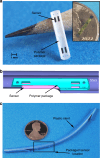A microsystem for in vivo wireless monitoring of plastic biliary stents using magnetoelastic sensors
- PMID: 39477941
- PMCID: PMC11526028
- DOI: 10.1038/s41378-024-00772-8
A microsystem for in vivo wireless monitoring of plastic biliary stents using magnetoelastic sensors
Abstract
With an interest in monitoring the patency of stents that are used to treat strictures in the bile duct, this paper reports the investigation of a wireless sensing system to interrogate a microsensor integrated into the stent. The microsensor is comprised of a 28-μm-thick magnetoelastic foil with 8.25-mm length and 1-mm width. Magnetic biasing is provided by permanent magnets attached to the foil. These elements are incorporated into a customized 3D polymeric package. The system electromagnetically excites the magnetoelastic resonant sensor and measures the resulting signal. Through shifts in resonant frequency and quality factor, the sensor is intended to provide an early indication of sludge accumulation in the stent. This work focuses on challenges associated with sensor miniaturization and placement, wireless range, drive signal feedthrough, and clinical use. A swine specimen in vivo experiment is described. Following endoscopic implantation of the sensor enabled plastic stent into the bile duct, at a range of approximately 17 cm, the signal-to-noise ratio of ~106 was observed with an interrogation time of 336 s. These are the first reported signals from a passive wireless magnetoelastic sensor implanted in a live animal.
© 2024. The Author(s).
Conflict of interest statement
The authors declare no competing interests.
Figures





Similar articles
-
In vivo and in situ evaluation of a wireless magnetoelastic sensor array for plastic biliary stent monitoring.Biomed Microdevices. 2013 Jun;15(3):509-17. doi: 10.1007/s10544-013-9750-3. Biomed Microdevices. 2013. PMID: 23460136 Free PMC article.
-
In situ and ex vivo evaluation of a wireless magnetoelastic biliary stent monitoring system.Biomed Microdevices. 2010 Jun;12(3):477-84. doi: 10.1007/s10544-010-9404-7. Biomed Microdevices. 2010. PMID: 20180152
-
Encapsulation Approaches for In-Stent Wireless Magnetoelastic Sensors.IEEE Trans Biomed Eng. 2018 Nov 20:10.1109/TBME.2018.2882415. doi: 10.1109/TBME.2018.2882415. Online ahead of print. IEEE Trans Biomed Eng. 2018. PMID: 30475708 Free PMC article.
-
Role of fully covered self-expandable metal stent for treatment of benign biliary strictures and bile leaks.Korean J Radiol. 2012 Jan-Feb;13 Suppl 1(Suppl 1):S67-73. doi: 10.3348/kjr.2012.13.S1.S67. Epub 2012 Apr 23. Korean J Radiol. 2012. PMID: 22563290 Free PMC article. Review.
-
Theory, instrumentation and applications of magnetoelastic resonance sensors: a review.Sensors (Basel). 2011;11(3):2809-44. doi: 10.3390/s110302809. Epub 2011 Mar 2. Sensors (Basel). 2011. PMID: 22163768 Free PMC article. Review.
References
-
- Libby, E. D. & Leung, J. W. Prevention of biliary stent clogging: a clinical review. Am. J. Gastroenterol.91, 67–78 (1996). - PubMed
-
- Frattaroli, F. M., Reggio, D., Guadalaxara, A., Illomei, G. & Pappalardo, G. Benign biliary strictures: a review of 21 years of experience. J. Am. Coll. Surg.183, 506–513 (1996). - PubMed
-
- Sung, J. J. Y. Bacterial biofilm and clogging of biliary stents. J. Ind. Microbiol.15, 152–155 (1995). - PubMed
-
- Davids, P. H., Groen, A. K., Rauws, E. A. J., Tytgat, G. N. & Huibregtse, K. Randomised trial of self-expanding metal stents versus polyethylene stents for distal malignant biliary obstruction. Lancet340, 1488–1492 (1992). - PubMed
Grants and funding
LinkOut - more resources
Full Text Sources
